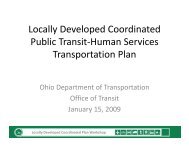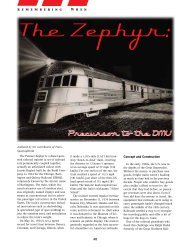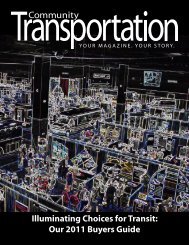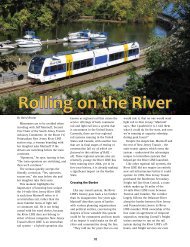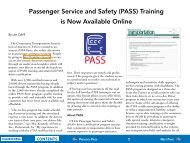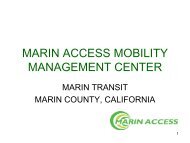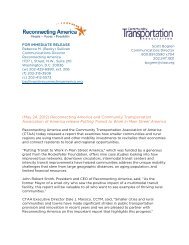San Luis Obispo - Caltrans - State of California
San Luis Obispo - Caltrans - State of California
San Luis Obispo - Caltrans - State of California
You also want an ePaper? Increase the reach of your titles
YUMPU automatically turns print PDFs into web optimized ePapers that Google loves.
SAN LUIS OBISPO REGION<br />
COORDINATED HUMAN SERVICES-PUBLIC TRANSPORTATION PLAN<br />
Low Income Individuals -- Families<br />
Consumers <strong>of</strong> public social service programs obtain assistance from agencies and<br />
organizations through various channels. They may be court referrals where there has been<br />
an allegation <strong>of</strong> child abuse or child neglect. These cases can be a probation referral, where<br />
the family is in danger <strong>of</strong> losing their children to out-<strong>of</strong>-home placement. Some families are in<br />
immigrant populations and are non-English speaking, or speak English with limited<br />
pr<strong>of</strong>iciency. Single parents, enrolled in Medi-Cal and Healthy Start programs or with children<br />
attending Headstart, are family units with typically more than one child. These are among the<br />
low-income clientele <strong>of</strong> responding human service agencies.<br />
This population is generally physically healthy, able to walk and move about the community,<br />
but may not own a car or the single working car in the family is used by the household wage<br />
earner. Use <strong>of</strong> fixed-route service is possible, but information must be readily accessible and<br />
services must not be so inconvenient as to discourage use. Consumers have one or more<br />
children, potentially making use <strong>of</strong> fixed route transit services more difficult.<br />
Pricing <strong>of</strong> transportation services is also an issue. This segment <strong>of</strong> the population is by<br />
definition low on financial resources, and therefore struggles with the expenditure <strong>of</strong> these<br />
scarce resources for transportation versus food and other basics.<br />
Low Income Individuals -- Homeless Consumers<br />
Individuals who are homeless or on the verge <strong>of</strong> homelessness have few to no resources and<br />
a single bus fare or token is usually beyond them. These consumers have very limited<br />
access to information and learning a bus route or the particular routing to get to a desired<br />
destination is a complicated task, simply because so many life issues impinge upon them.<br />
Similarly, even where the individual might qualify for ADA paratransit, they have limited to no<br />
success to a telephone to schedule a trip pick-up. There can be children accompanying a<br />
homeless individual, usually a female, all <strong>of</strong> whom need bus fares. In some instances, as<br />
with children participating in after-school programs and shelter-oriented activities, very young<br />
children may be traveling alone.<br />
For these persons, so many activities <strong>of</strong> daily living are difficult and complicated.<br />
Caseworkers hope to make the transportation element easier so that access to jobs and a<br />
better quality <strong>of</strong> life become more readily possible. However agency personnel also note that<br />
reported transportation problems are sometimes used as a reason for “not trying”. Where<br />
these legitimate difficulties can be eased or smoothed, it encourages the individual to grapple<br />
with the “culture <strong>of</strong> poverty” and work to better their circumstances.<br />
6.3.2 Organizationally-Oriented Characteristics <strong>of</strong> Need<br />
Trip Types Needed<br />
Organizations surveyed were well aware <strong>of</strong> selective consumer needs and both public transit<br />
and human services agencies spoke to the need for medical transportation and the crossjurisdictional,<br />
long-distance trips that typify non-emergency medical trips. This is despite<br />
Ride-On’s ability to provide Medi-Cal transportation as a Medi-Cal vendor.<br />
101<br />
OCTOBER 2007



